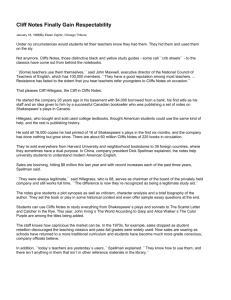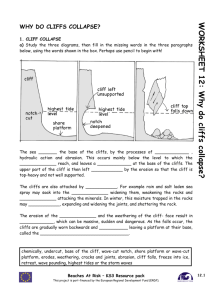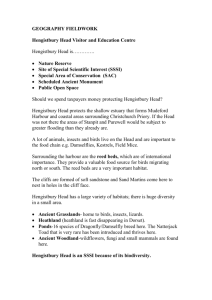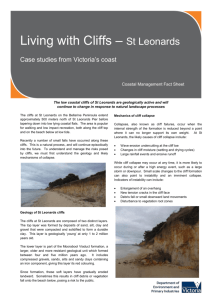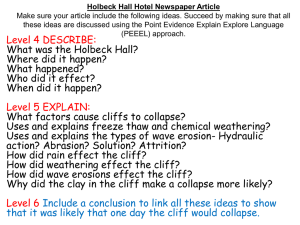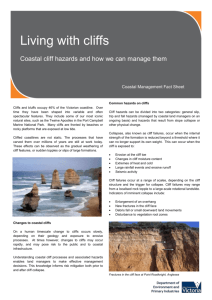Living with cliffs - Port Campbell [MS Word Document
advertisement
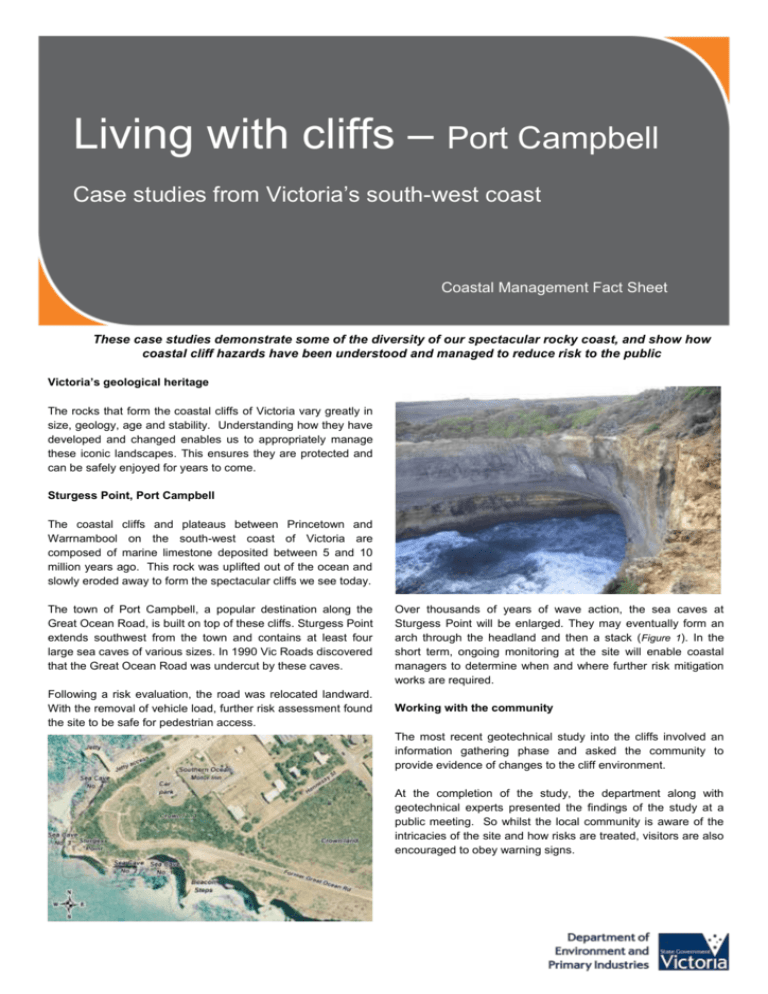
Living with cliffs – Port Campbell Case studies from Victoria’s south-west coast Coastal Management Fact Sheet These case studies demonstrate some of the diversity of our spectacular rocky coast, and show how coastal cliff hazards have been understood and managed to reduce risk to the public Victoria’s geological heritage The rocks that form the coastal cliffs of Victoria vary greatly in size, geology, age and stability. Understanding how they have developed and changed enables us to appropriately manage these iconic landscapes. This ensures they are protected and can be safely enjoyed for years to come. Sturgess Point, Port Campbell The coastal cliffs and plateaus between Princetown and Warrnambool on the south-west coast of Victoria are composed of marine limestone deposited between 5 and 10 million years ago. This rock was uplifted out of the ocean and slowly eroded away to form the spectacular cliffs we see today. The town of Port Campbell, a popular destination along the Great Ocean Road, is built on top of these cliffs. Sturgess Point extends southwest from the town and contains at least four large sea caves of various sizes. In 1990 Vic Roads discovered that the Great Ocean Road was undercut by these caves. Following a risk evaluation, the road was relocated landward. With the removal of vehicle load, further risk assessment found the site to be safe for pedestrian access. Over thousands of years of wave action, the sea caves at Sturgess Point will be enlarged. They may eventually form an arch through the headland and then a stack ( Figure 1). In the short term, ongoing monitoring at the site will enable coastal managers to determine when and where further risk mitigation works are required. Working with the community The most recent geotechnical study into the cliffs involved an information gathering phase and asked the community to provide evidence of changes to the cliff environment. At the completion of the study, the department along with geotechnical experts presented the findings of the study at a public meeting. So whilst the local community is aware of the intricacies of the site and how risks are treated, visitors are also encouraged to obey warning signs. Living with cliffs Figure 1: Sequential erosion at a rocky headland forming a) sea cave b) arch and c) stack (adapted from Bird 1993). Risk management on cliffs What can I do to help? Coastal managers are encouraged to consider risk mitigation strategies that are proportionate to the type and intensity of use, protecting public safety where required while maintaining the natural character of the coastline. The Sturgess Point demonstrate the different risk management approaches for a high-use town centre coastline. A cliff collapse adjoining a township would likely cause more damage to life or infrastructure. Therefore at Sturgess Point a combination of risk mitigation strategies, including geotechnical assessments, are required. Avoid walking near cliff edges or at the base of cliffs and encourage others to do the same Keep to formalised paths at the cliff top Do not climb on cliffs as this can cause localised damage and increase the rate of erosion Avoid damaging vegetation: vegetation promotes water infiltration and reduces erosive runoff Obey all signs and stay behind safety fences If you see evidence of a recent slip or collapse, take a photo and report it to your local land manager. Ongoing monitoring and review of coastal risks helps ensure timely implementation of any new mitigation actions where required, so that the public can continue to safely enjoy these spectacular rocky landscapes. Published by the Victorian Government Department of Environment and Primary Industries Melbourne, September 2013 © The State of Victoria Department of Environment and Primary Industries Melbourne September 2013 This publication is copyright. No part may be reproduced by any process except in accordance with the provisions of the Copyright Act 1968. References: Bird, E.C.F., 1993. The Coast of Victoria. Melbourne University Press, Melbourne 324 pp. www.depi.vic.gov.au Accessibility If you would like to receive this publication in an alternative format, please telephone DEPI Customer Service Centre 136 186, email customer.service@dse.vic.gov.au (or relevant address), via the National Relay Service on 133 677 www.relayservice.com.au This document is also available in on the internet at www.depi.vic.gov.au Disclaimer This publication may be of assistance to you but the State of Victoria and its employees do not guarantee that the publication is without flaw of any kind or is wholly appropriate for your particular purposes and therefore disclaims all liability for any error, loss or other consequence which may arise from you relying on any information in this publication.

